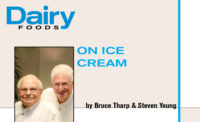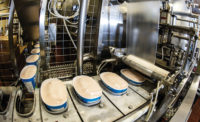The U.S. Food and Drug Administration recently proposed a supplemental rule updating the pending revision of Nutrition Facts Labels. The proposal adds a Daily Value for intake of “added sugars” (sugars not naturally occurring in any specific food) as 10% of total calories per person per day (or 50 grams, based on recommendations by a number of expert panels from government, academia and consumer organizations).
We assume “added sugars” to be the sum of all nonlactose mono- (DP1), disaccharides (DP2) and smaller saccharides. There is no consideration (as yet) related to the caloric content of individual “added sugars” which can vary greatly (0.2 to 4.0 calories per gram.) A key point, but argumentative for now.
FDA references the current consumption of “added sugars” in the United States to be 16% of total calories, but concentrated in a few product categories of which ice cream and related products are included. A number of unknowns, conflicts and questions related to terminologies will need to be addressed during the comment period that began July 27. All this is in addition to earlier proposals changing the current standard serving size for ice cream from 4 fluid ounces to a proposed 8 fluid ounces (but leaving single-serve handheld novelties as they are).
Sugar’s important role in ice cream
Ice cream is unique in that it is designed to be consumed frozen. The ability to retain desirable sensory appeal across the rigors of storage and distribution (“heat shock”) calls for formulation management of a variety of mix elements. Among these elements are freezing point, water mobility control and post-freezing product flow properties. Thus, the use of any one or more of the various sweetener options heavily depends on what needs to be said about the final frozen dessert for desired flavor, body/texture, labeling declarations, and, ultimately, economic benefit.
In advance of any final regulatory decisions, the following ingredients and approaches may help manage the total amount of added sugars in frozen desserts. In each case, formulating with care is necessary. Here are seven sweetening systems and issues to ponder.
High-intensity sweeteners with purified/recombined elements. The number of high-intensity sweeteners and their extracts, with improved sensory qualities, are ever increasing, adding to flexibility when using high-intensity sweeteners.
“Rare sugars.” These are sugars of varying intensity and quality of sweetness found in nature at low levels. They are impractical to isolate and use. They can deliver clean sweetness quality with low-to-no caloric contribution. Rare sugars can now be enzymatically synthesized from naturally occurring sugars (fructose, galactose, lactose, etc.), providing novel formulation opportunities. The most recent rare sugar is allulose (0.2 calories per gram), an epimer of fructose with sweetness quality similar to sucrose. Rare sugars also present an enigma in the context of the rationale for added sugar labeling since they are “added sugars” but make an insignificant caloric contribution to the final food.
Non-“sugar” carbohydrates. Digestion-resistant oligo- and higher saccharides, and sugar alcohols (including polyglycitols) can provide properties that are useful in dealing with the impact of added-sugar labeling considerations on formulation with regard to management of freezing profile, water mobility control and calories.
Polysaccharides created during culturing. Sweetness can be managed by leveraging the development of ex-polysaccharides created during the culturing of yogurts, cultured buttermilks, sour creams, etc. In the “added sugar” context, that may allow fewer added sugars, more water mobility control, etc., and thus offer both operational and labeling benefits.
Hydrolysis of lactose. Beyond simple “lactose-free” objectives, given lactose’s limited sweetness (~20% that of sucrose), the enzymatic hydrolysis of lactose to its sweeter component monomers glucose and galactose may yield a four-fold increase in sweetness without increasing total sugars. Leveraging such sweetness, albeit, at low levels, could reduce the need for other added sugars.
Sucrose-like sweetness without calories. Not all sweetness is created equal, nor are all sweetness levels compatible with all flavors, nor do all “sugars” have the same caloric value. This creates both formulation opportunities and concerns.
Cost per unit sweetness. Considerations regarding the cost per unit sweetness associated with value-added rare sugars, purified/recombined extracts, lactose hydrolysis products and the like, although applicable, may be misleading. The economics of miscellaneous “more natural,” “near sucrose” and/or lower “added sugar” ice creams needs to be considered not only in a given formula but also in context of a full product line.
Ask Tharp and Young
For more on sweeteners, sugars and formulation approaches, join Bruce Tharp and Steve Young at Tharp & Young on Ice Cream Technical Short Course Workshops and Clinics, Dec. 2 to 4, 2015, in Las Vegas. For short course information, go to www.onicecream.com or call 610-975-4424; 281-596-9603.



